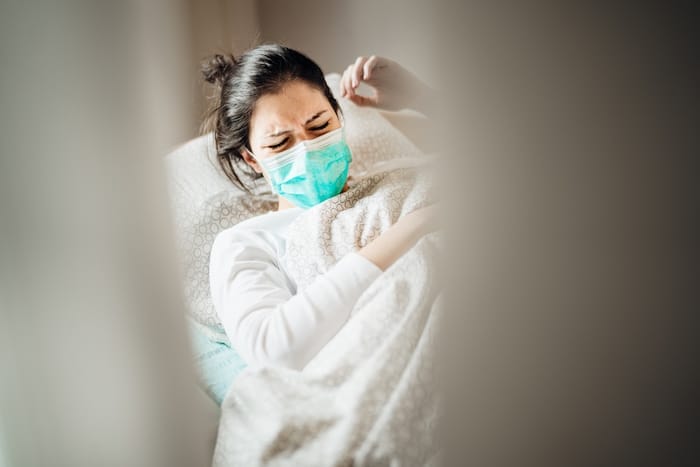Photo credit: Depositphotos
By Emily Shaughnessy
The healthcare system has been the frontline of the fight against the COVID-pandemic, but what happens when the safety of hospital staff and patients is compromised?
Over the past year, healthcare facilities across the country have scrambled to adapt to rapidly changing protocol and processes and to accommodate the influx of patients infected with the highly contagious SARS-CoV-2 virus. Despite an abundance of caution, thousands of healthcare workers have been exposed to or infected with the COVID virus during the past 12 months, and the risk of COVID transmission within healthcare facilities has become a primary concern.
Hospital-acquired infections are worrisome during normal times—the Centers for Disease Control and Prevention estimates that 1 in 31 hospital patients has an HAI on any given day—but they become terrifying during a global health crisis.
In October, the CDC officially acknowledged the airborne transmission of COVID-19. While the virus primarily spreads through large respiratory droplets emitting when an infected person coughs or sneezes, the possibility of airborne spread means that transmission can happen through tiny particles that travel farther than 6 feet or that linger in the air, even after an infected person has exited the room.
SARS-CoV-2 is not the only pathogen that spreads through the air. Other viruses and bacteria— such as those that cause tuberculosis, measles, and chicken pox—spread easily through airborne routes and hospitals take precautions to prevent this from happening.
One common preventative measure taken in healthcare facilities is the maintenance of “negative pressure rooms,” in which more air is pumped in than flows out. This helps reduce the chance that contaminated air can spread between patients, staff and visitors. Another related safety precaution is the testing and balancing of HVAC systems to ensure that air is circulating as intended.
However, there are some major flaws in the current system for managing and monitoring the air conditions in healthcare facilities—and the coronavirus pandemic has shone a giant spotlight on these oversights.
Traditionally, air balancing and testing has been viewed as a disruptive process. Conventional methods are very time-consuming and cumbersome, and rely primarily on handwritten notes and excel spreadsheets to track air conditions. Because of that, many hospital systems only routinely audit the air in critical areas, which is usually approximately 15-20% of a given facility.
This can lead to a false sense of security regarding the quality of hospital air, and can also put hospitals in a reactive position instead of a proactive one. The reality is that airborne infections are not just limited to a few rooms; the risk of infection exists throughout the entire facility. During COVID-19 there has been a massive increase in demand for isolation and negative pressure rooms, and not all hospitals have been able to accommodate, which places patients and staff at risk.
Steven Manz, co-founder of Austin-based Life Balance Technologies, said that updating air testing and monitoring processes and systems had not previously been a priority because the chance of a widespread airborne disease seemed so remote. Then the pandemic hit.
“Facility-wide testing was time-consuming, costly and unmanageable,” Manz said. “Building owners have invested billions of dollars in energy efficient systems to reduce their utility bills, but very few have invested tools to maintain the airflow standards needed for a safe environment.”
According to Manz, the key to helping hospitals reduce the spread of COVID-19 and other airborne diseases will be to integrate new technology and upgrade outdated systems of tracking air quality.
Prior to the COVID-19 pandemic, Life Balance Technologies co-founder Corey Kilpack developed a unique process for measuring and testing the parameters needed to minimize airborne infection risk, and it became the basis of Life Balance’s signature software, SāfAir. This software helps hospitals and other healthcare facilities more accurately and affordably test and monitor their air flow and quality.
For example, SāfAir analyzes infection control parameters from 100% of a facility—instead of just 15-20%—and can provide reports more quickly and effectively, which allows hospitals to track potential risks and reduce hospital-acquired infections.
Life Balance has already applied their software in several hospital systems in California and is looking to onboard other healthcare facilities as quickly as possible to help limit COVID-19 transmission.
“The feedback we’re getting is that SāfAir is unique and there’s obviously a huge need for this—so keep going” Manz said. “Hospitals want safer facilities and they need to achieve this with tighter or limited budgets. We are helping them do more with less money.”
The Editorial Team at Healthcare Business Today is made up of skilled healthcare writers and experts, led by our managing editor, Daniel Casciato, who has over 25 years of experience in healthcare writing. Since 1998, we have produced compelling and informative content for numerous publications, establishing ourselves as a trusted resource for health and wellness information. We offer readers access to fresh health, medicine, science, and technology developments and the latest in patient news, emphasizing how these developments affect our lives.









1 thought on “How New Technology Can Help Hospitals Reduce COVID-19 Spread”
Comments are closed.